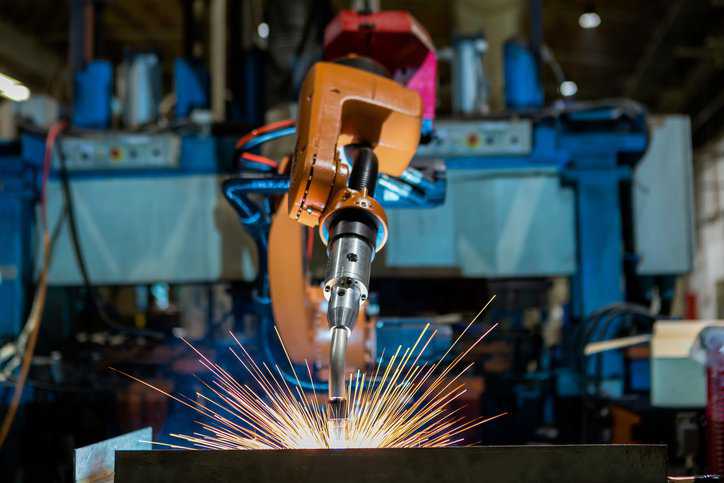AWS D16.1M/D16.a:2018— Robotic Arc Welding Safety

Robotic arc welding is a type of automated robotic welding technique that uses an electric arc to melt and join metals together. Welding robots are typically stationary and are used to repeatedly perform the same welding operation. This process helps the industrial sector automate its processes, improve accuracy, and enhance safety of personnel. AWS D16.1M/D16.a:2018—Specification for Robotic Arc Welding Safety provides specifications for arc welding robot systems.
Safety of Robotic Arc Welding
By taking the human element out of the welding process, robots eliminate operator dangers, such as electric shock, exposure to gases, toxic fumes, and flash burns to the eye’s cornea. However, with the implementation of robots, new dangers have replaced the old ones. This is why it is critical for manufacturers to follow best safety practices like those detailed in AWS D16.1M/D16.a:2018 when implementing a robotic welding program.
What Is AWS D16.1M/D16.a:2018?
AWS D16.1M/D16.a:2018 establishes safety requirements for the design, manufacture, maintenance, and operation of arc welding robot systems and ancillary equipment. The requirements of this standard specifically apply to industrial robot systems that are used to perform the gas metal arc welding (GMAW) with solid or metal cored wires, and flux cored arc welding (FCAW) processes.
Industrial robot system refers to “equipment that includes the robot(s) (hardware and software) consisting of the manipulator power supply and control system; the end-effector(s); and any other associated machinery and equipment within the safeguarded space.” AWS D16.1M/D16.a:2018 helps to identify and minimize hazards involved in maintaining, operating, integrating, and setting up of arc welding robot systems.
What Are the Safety Hazards from Arc Welding?
Health hazards from welding, cutting, and brazing operations include exposures to metal fumes and to ultraviolet (UV) radiation. To mitigate the impact of welding emissions, manufacturers typically implement proper ventilation and filtration systems.
Besides hazards from fumes and gases, other safety hazards from arc welding include burns, eye damage, electrical shock, cuts, and crushed toes and fingers. Many of these can be controlled with proper work practices and personal protective equipment (PPE); however, implementing a proper risk assessment is critical for fully assuring the utmost protection of operator and personnel.
Risk Assessment of Arc Welding Robot Systems
AWS D16.1M/D16.a:2018 details that the integrator and user should perform a risk assessment on the arc welding robot system and ancillary equipment to determine if the safeguarding achieves and maintains a safe work environment. The standard further notes that potential hazards to personnel should be eliminated by design, or otherwise protection should be provided against the hazards.
The risk assessment should comply with the requirements of AWS D16.3M/D16.3.
Weld Program Verification
AWS D16.1M/D16.a:2018 details that robot welding programs can be verified visually by trained operators and technicians. The standard states that the procedures for verifying the robot welding should include the following requirements:
- Personnel should be trained on the safe use of the robot, the welding process, and the system requirements prior to performing program verification.
- The program should be executed without the welding arc being on to verify the actual weld path and control function of the robot.
- One trained individual should observe the actual welding process in the restricted space.
AWS D16.1M/D16.a:2018—Specification for Robotic Arc Welding Safety is available on the ANSI Webstore.






